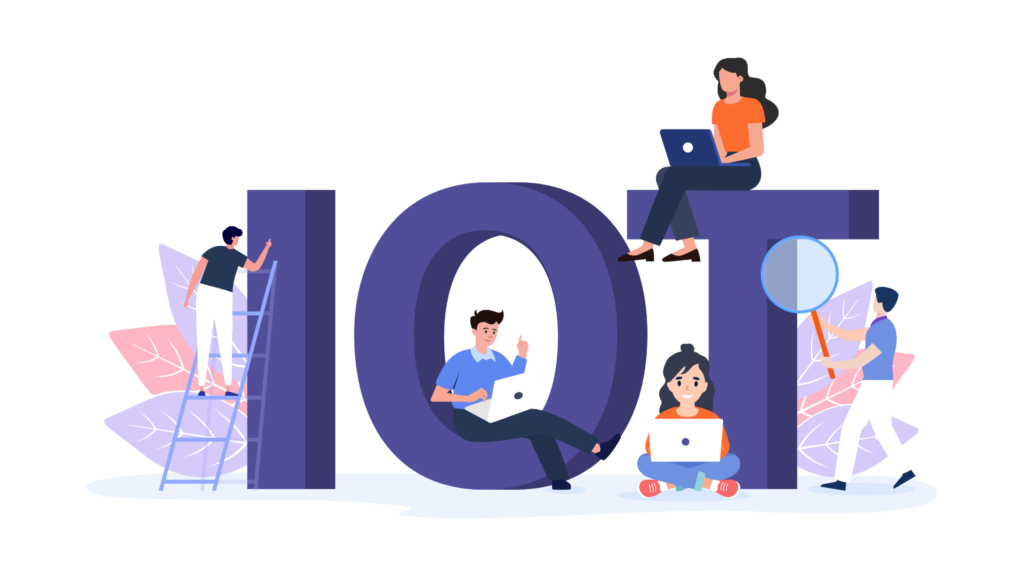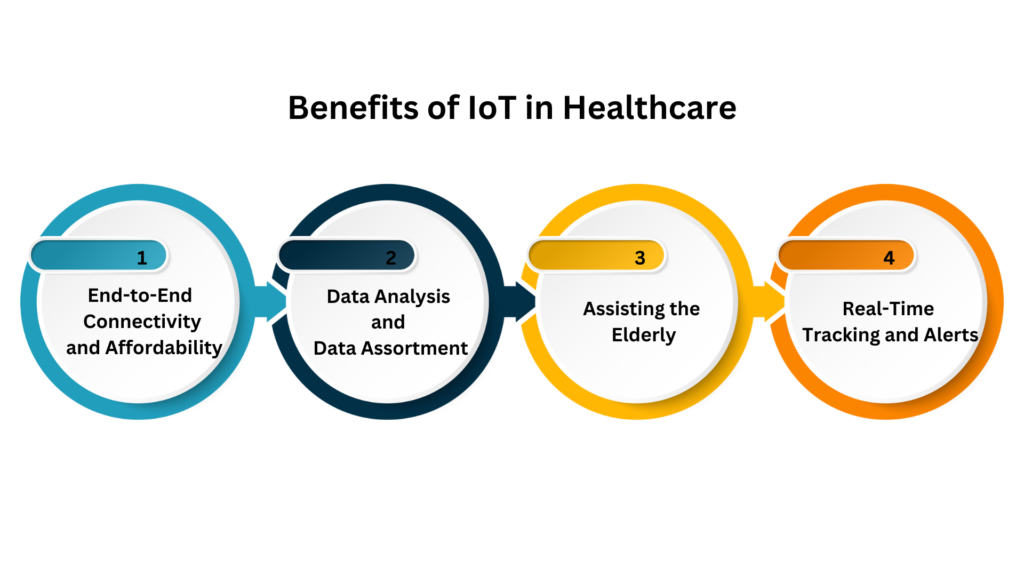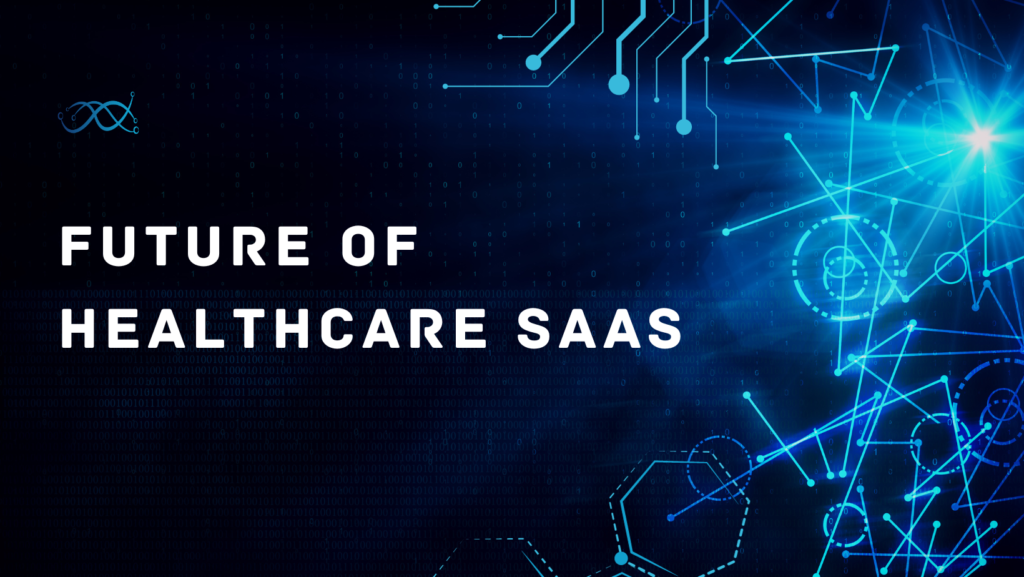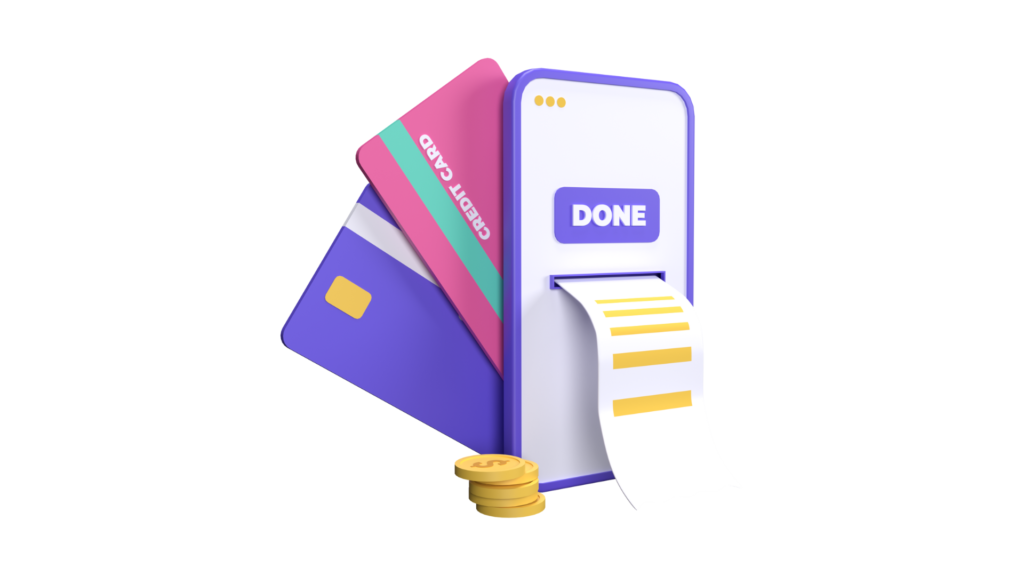The rapid expansion of IoT in healthcare has significantly increased its impact globally. IoT applications in healthcare are widespread, ranging from enhanced machinery management to virtual medical support. This advanced technology holds the promise of saving lives through swift disease detection and the pinpointing of appropriate treatment choices for patients.
In this blog post, we’ll explore the revolutionary effects of IoT on healthcare, investigating its benefits, use cases, and the challenges linked to its integration into the industry. Without further delay, let’s commence this exploration.

Where Does Fit IoT in Healthcare?
As IoT technology advances, the Internet of Medical Things (IoMT) is revolutionizing the healthcare sector, enhancing patient well-being and facilitating virtual connections between doctors and patients.
The Internet of Medical Things (IoMT) is a system of interconnected devices that gather real-time data. It stands as a crucial application of IoT in healthcare, bringing about positive effects on the industry and offering the potential to address medical challenges.
The Internet of Medical Things has allocated distinct segments for addressing each medical challenge the healthcare industry encounters.
On-body Segment – The On-body Segment emphasizes consumer health wearables and other medical-grade wearable devices. Examples of products within this segment include Fitbit, Apple Watch, Amazfit Smartwatches, and more.
In-Home Segment – In the In-Home segment, the focus is on tailored health-tracking solutions designed for individuals. This category includes Personal Emergency Response Systems (PERS), virtual visits through telehealth, and Remote Patient Monitoring (RPM).
Community Segment – It is composed of five elements: Dispensing kiosks for providing products and services, mobility services for patients’ vehicles, emergency response intelligence, point-of-care devices resembling medical camps, and logistics for maintaining records of all medical equipment and goods.
In-Clinic Segment – This segment incorporates IoMT devices designed for use within a clinic setting to deliver healthcare services. The in-clinic segment’s medical IoT solutions also encompass point-of-care devices.
In-Hospital Segment – This encompasses diverse IoT healthcare solutions designed for multiple management domains. Devices within this segment include asset management monitors, personnel management systems, patient flow management tools, inventory management systems, and devices for environment and energy monitoring.
Exploring the applications of IoT in healthcare from a stakeholder perspective reveals a widespread influence on patients, physicians, and hospitals throughout the industry. To delve deeper into this, let’s continue reading.
For Patients
Healthcare wearable smart devices, such as glucometers, heart rate cuffs, fitness bands, etc., provide patients with personalized care. The continuous tracking capability of these devices can significantly benefit individuals living alone, as they can send alerts to their family members.
For Physicians
By employing medical IoT wearables and home monitoring devices that are integrated with IoT technology, physicians can elevate the monitoring of patient’s health. The information gathered from these IoT healthcare devices empowers doctors to discern optimal treatment and monitoring approaches, converging the domains of the Internet of Things and healthcare to enhance outcomes.
For Hospitals
Within hospitals, IoT is integrated with sensors to monitor the real-time location of medical tools and equipment, including defibrillators, wheelchairs, oxygen pumps, nebulizers, and similar monitoring devices. Additionally, this technology facilitates the analysis of the deployment of medical staff across various locations.
How Does the Internet of Healthcare Things (IoHT) Work?
IoT products generally operate through a four-stage process systematically implemented by medical IoT companies. Each stage is closely integrated in terms of data capture and processing.

1. Implementation of Interconnected Devices – This entails the use of sensors, actuators, monitors, detectors, and camera systems for data collection.
2. Digitization of Data – The analog data obtained from sensors and other devices is aggregated and transformed into a digital format.
3. Cloud Migration – Following the pre-processing and standardization, the data is moved to a cloud data center.
4. Insight Extraction – Advanced analytics are employed on the processed data post-management and analysis, yielding actionable insights.
What Are the Benefits of IoT in Healthcare?
The integration of IoT in healthcare is revolutionizing the way hospitals cater to patients. Despite challenges presented by rapid population growth, which directly or indirectly leads to heightened illnesses and aging populations, the adoption of IoT healthcare solutions holds the promise of effectively addressing these issues. It’s undeniable that IoT and healthcare are inherently interconnected. Below are some of the most significant advantages of the Internet of Things.

End-to-End Connectivity and Affordability
In healthcare applications, the Internet of Things facilitates improved connectivity and the utilization of the latest technology for enhanced data sharing. Utilizing features like Bluetooth, Wi-Fi, and others makes the process of tracking and identifying illnesses more efficient and less time-consuming.
Enhancing Healthcare Coordination and Cost Efficiency through IoT Integration
As an illustration, IoT can establish connections among various devices and systems within a hospital, fostering better care coordination. Furthermore, healthcare companies embracing IoT can use the technology to decrease care costs by enhancing efficiencies and improving patient outcomes.
Remote Patient Monitoring and Medication Adherence with IoT Technology
IoT also aids in the remote monitoring of patients with chronic conditions, potentially resulting in decreased hospital readmissions. Likewise, the utilization of smart pills and wearable sensors can enhance medication adherence and prevent adverse events.
Data Analysis and Data Assortment
The advantages of IoT in healthcare include the storage of extensive patient medical history data. IoT devices transfer data to one another, and although analyzing such vast datasets may appear daunting, IoMT devices can perform this task within minutes.
IoT medical devices can collect, analyze, track, send, and receive data through a cloud-based system. The use of a cloud-based infrastructure is essential, as storing these vast datasets on a server is not feasible.
Assisting the Elderly
A significant domain reaping substantial benefits from the integration of IoT healthcare solutions is the support of the elderly. Outfitting seniors with IoT medical devices capable of monitoring vital signs and issuing medication reminders allows caregivers to deliver elevated care, thereby mitigating the risk of hospitalization or other health complications.
Furthermore, IoT-enabled devices are employed to monitor falls and promptly notify caregivers in case of emergencies. For instance, Apple has incorporated a fall detection system in its Apple Watches that can identify if the user experiences a fall.
As the elderly population increases and the demand for top-notch healthcare grows, the importance of IoT solutions has surged, playing a crucial role in ensuring that seniors receive the essential care they need.
Real-Time Tracking and Alerts
Consider the potential lives saved through emergency alerts initiated by patients—a possibility made achievable by the Internet of Medical Things. Through the utilization of smart healthcare devices, a patient’s real-time medical information is documented and can be transmitted to the doctor. In the event of any potential threat, the doctor receives immediate notification and can assist accordingly.
Real-time Abnormal Heart Rate Alert System via Wearable IoT Devices
Consider a scenario where a patient with a heart condition is equipped with a wearable device that constantly monitors their heart rate. In the event of detecting an abnormal heart rate, the device could promptly notify the patient’s doctor in real-time. This timely alert would enable the doctor to take immediate action, potentially averting a serious health complication.
IoT in Healthcare Use Cases
The healthcare IoT industry harnesses the power of the Internet of Things for impactful initiatives. Ranging from patient monitoring to virtual assistance, the applications of the Internet of Things in healthcare are extensive and diverse. Here are some notable use cases in IoT healthcare.
Remote Patient Monitoring
A primary IoT healthcare use case addressed by custom healthcare software development companies is remote patient monitoring. Medical IoT devices are designed to gather essential health metrics, including blood pressure, heart rate, temperature, etc., from patients who are not physically within the healthcare facility. Advanced algorithms play a crucial role in analyzing these vital signs, providing treatment recommendations, or triggering alerts when necessary.
Reduced Waiting Time
Patient satisfaction stands as a crucial metric in healthcare, and diminishing waiting time is a strategy to enhance patient satisfaction scores. IoT can contribute to the reduction of waiting time through various means. For instance, IoT-enabled patient check-in can expedite the registration process.
Moreover, IoT-connected devices can track the real-time location of patients and staff, optimizing the flow of patients throughout the facility. By minimizing waiting times, IoT becomes instrumental in enhancing the overall patient experience and elevating satisfaction scores.
Monitoring Employees and Patients
In large hospital complexes, keeping tabs on the whereabouts of every employee or doctor at a given moment can be a daunting task. The same holds for all patients. However, with healthcare IoT technology, tracking patients and staff becomes a seamless process.
This technology is equally adept at monitoring the hospital’s assets for security purposes. It proves to be a highly efficient solution for tracking objects or individuals without incurring additional costs or effort.
Medication Management
Through IoT-enabled devices, patients can receive timely alerts when it’s time to take their medication. The data gathered by these devices is also valuable for monitoring medication adherence and identifying potential issues with drug therapy.
Additionally, IoT plays a role in overseeing the storage and transportation of medications, guaranteeing they are maintained at the correct temperature and safeguarded against tampering. By enhancing the efficiency and effectiveness of drug management, IoT holds the potential to enhance patient outcomes and decrease healthcare costs.
Detection of Chronic Diseases
IoT healthcare technology plays a pivotal role in identifying a patient’s chronic illnesses. Patients input their symptoms, and IoT healthcare devices cross-reference this information with existing data to pinpoint the specific disease.
Wearable devices, such as Fitbit, monitor metrics like heart rate, sugar levels, and blood pressure. The development of healthcare apps for wearables and mobile devices has heightened people’s health consciousness and awareness of their medical conditions.
Examples of the IoT Medical Devices
Healthcare IoT devices exemplify technical ingenuity. They prove invaluable in reducing waiting times in emergency rooms, tracking patients, staff, and inventory, ensuring discipline in drug management, and ensuring the availability of critical hardware at all times.
Healthcare professionals have broadened the scope of IoT in the healthcare sector by facilitating providers to deliver services beyond traditional clinical settings. For example, diverse IoMT devices, such as home monitoring systems, empower both patients and healthcare professionals to consistently monitor an individual’s health. This diminishes the necessity for costly and time-consuming in-person doctor visits.
Remote Patient Monitoring (RPM) technology has become a highly sought-after IoT solution adopted by healthcare systems and hospitals in the United States. It involves the use of interconnected IoT devices equipped with sensors to provide healthcare providers with a continuous stream of real-time health data. This data encompasses vital signs like heart rate, blood pressure, and glucose levels.
Hearables
The invention of the hearing aid can be attributed to the ingenuity of Miller Reese Hutchison, and over the years, these devices have undergone significant evolution, transforming into IoT healthcare devices that revolutionize the experience for individuals with hearing loss. These modern “hearables” are seamlessly connected to smartphones through Bluetooth. They offer features such as sound filtering, equalization, and customization, allowing users to experience a more tailored and realistic audio environment.
As an illustration, Fitbit, a prominent player in the wearable healthcare technology market, has been delivering innovative products for several years. Their latest wearable, the Versa, incorporates a range of health-tracking features, including a sleep tracker, heart rate monitor, daily reminders, and on-screen workouts.
Moodables
Stress frequently contributes to deteriorating mental health, and individuals facing mental disorders or neurovascular issues may require mood upliftment. Several mood-enhancing devices created by companies such as Melon, Muse, and Emotiv assert their efficacy in addressing post-traumatic stress disorder and promoting relaxation among patients. Positioned on the head, these devices administer low-intensity currents to the brain, harnessing electrical impulses to alleviate pain and uplift the mood.
Smart Thermometers
The collection and transmission of health data through IoT devices have the potential to revolutionize healthcare delivery. Continuous monitoring of a patient’s temperature can be achieved using smart thermometers, offering real-time data that enables the early detection of signs of illness.
Integration with other IoT devices, such as blood pressure and heart rate monitors, can be facilitated by connecting these smart thermometers. This interconnected approach provides a more holistic perspective on a patient’s health, enabling the early identification of potential issues.
Challenges Faced in IoT-based Healthcare System
While IoT proves beneficial in the healthcare industry, it is not without limitations and challenges. Let’s explore the adoption challenges of IoT in healthcare:
Privacy and Security
Privacy and security are significant concerns despite the numerous applications of IoT in healthcare. The substantial volume of data transferred and stored regularly poses a potential threat, as it can be vulnerable to hacking, leading to misuse by both patients and healthcare professionals. The Future of IoT in Healthcare.
Hackers can create fake IDs to buy drugs and medicines only to misuse them further. A solution to this pestering issue, however, lies in following the healthcare compliance set up by the government to ensure prescription safety.
Multiple Devices and Protocol Integration
The IoT environment is intricate, encompassing diverse devices, protocols, and standards. Integrating IoT solutions into existing healthcare infrastructures can be challenging due to this complexity. Moreover, the use of incompatible protocols by IoT healthcare devices adds a layer of complexity to integration efforts.
To overcome these challenges, healthcare organizations need to collaborate with seasoned IoT solution providers. These partners can assist in navigating the intricate landscape, aiding in the selection of suitable devices and protocols tailored to their specific requirements. Collaborating with a proficient healthcare IT consulting services partner is crucial for medical organizations to fully harness the benefits of IoT in healthcare.
Overloading and Inaccuracy
The challenges of overloading and inaccuracy arise when dealing with patient data, as it involves managing an overwhelming amount of information. The extensive data collected by IoT devices can lead to challenges in interpretation and decision-making, potentially resulting in decision fatigue and inaccurate diagnoses. Furthermore, the inherent lack of precision in sensors and devices may contribute to mismatched or incomplete data sets. Therefore, it is crucial to thoughtfully consider the utilization of IoT technology in healthcare to mitigate these challenges.
Cost of the Technology
It may come as a surprise to find IoT costs listed among the challenges. However, the reality is that IoT has the potential to decrease treatment expenses for individuals who have not experienced cost reduction yet. Achieving cost-effectiveness in the intersection of IoT and healthcare is a gradual process that requires time. This dynamic has given rise to a scenario akin to medical tourism, where individuals seek treatment in developing countries due to the considerably lower costs.
How Can Digiatto IT Services Pave the Way to Your IoMT Success?
Our team of experts specializes in integrating IoT into healthcare systems. As a bespoke healthcare software development company, we provide a range of services and solutions tailored to leverage this technology. We offer support in data collection, analysis, system integration, and ongoing assistance to maximize its potential in the medical field.
Our team of IoT application developers is fully prepared to assist you with your app concept, regardless of its complexity. Contact us today to get started!
FAQs
How is the Internet of Things applied in the field of healthcare?
Numerous applications of the Internet of Things can be utilized for the benefit of individuals in the healthcare sector. Patients, doctors, medical staff, families, and insurance companies can leverage these applications to monitor crucial data and receive updates related to the individuals under care. This enhances the vigilance of healthcare professionals, reducing the risk of negligence.
How will the Internet of Things (IoT) impact the healthcare sector?
Through cutting-edge healthcare IoT solutions, IoT significantly improves the patient care process by:
- Enabling real-time monitoring
- Implementing IoT smart pills
- Managing diabetes effectively
- Utilizing smartwatches for the treatment of major depressive disorder (MDD)
- Monitoring blood pressure
What does smart technology mean in the context of healthcare?
Smart technology in healthcare adheres to contemporary methodologies to enhance patient workflows. This technology employs wearable devices equipped with IoT technology, enabling access to extensive information with automated responses and facilitating communication between relevant parties, including individuals or institutions. The healthcare ecosystem has experienced enhanced accuracy and speed through the adoption of this technology.
Why is IoT crucial in healthcare?
As healthcare advances swiftly through technological integration, IoT contributes significant value to the industry.
The incorporation of the Internet of Things in healthcare facilitates vigilant and careful monitoring of patients, offering convenience. Additionally, this technology plays a crucial role in devising preventive measures. The data gathered through devices and wearables aids medical experts in prognosis and diagnosis.



Pingback: Cloud Computing in Healthcare Industry - HealthSaaSPro
Pingback: Business Guide to Healthcare Application Development in 2024 - HealthSaaSPro
Pingback: How to Ensure Cybersecurity in the Age of IoT - HealthSaaSPro
Pingback: The Use of Machine Learning in Healthcare - HealthSaaSPro